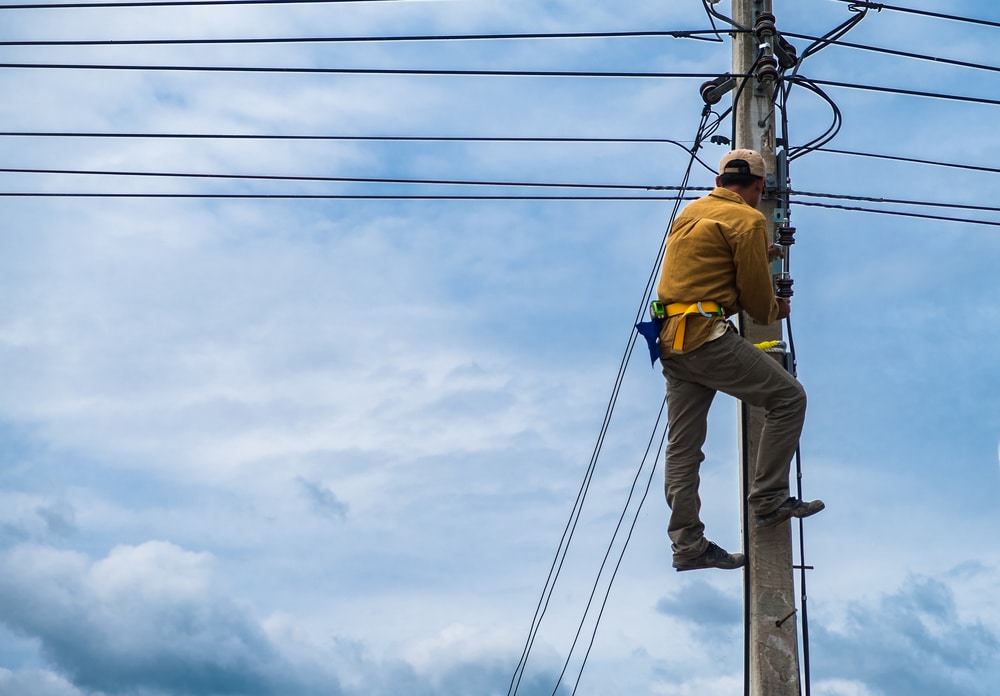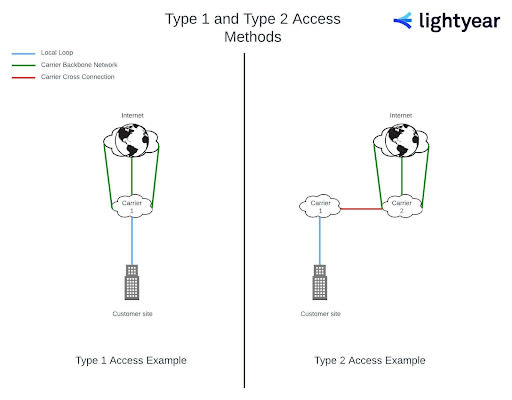Considerations When Buying Type 2 vs. Type 1 Connectivity Services
Have providers ever confused you by noting that they're selling you a Type 2 DIA rather than a Type 1 circuit? If so, this guide will clarify a few things.

Aug 5, 2022
SHARE
Have you ever been in the market for a dedicated internet access line and quoted several vendors only to be told by some of the vendors that they’re selling “Type 2 access” rather than “Type 1 access?” If that terminology has confused you in the past, this guide should clarify a thing or two for you.
The Local Loop
Before we can adequately define Type 2 vs. Type 1 connectivity, we must first explain the concept of the Local Loop. The Local Loop, sometimes referred to as the “last mile,” is the physical link between an end customer’s demarcation point and the telecom service provider’s network. Simply put, this is the wired / wireless infrastructure that connects your DIA circuit’s endpoint to the ISP’s central office that then connects back to the ISP’s core network. All common connectivity services “ride” the Local Loop or last mile of an ISP, including internet connectivity, point-to-point WAN connectivity, wavelengths service, MPLS, and the like. This is often referred to as “last mile” connectivity because the link between an ISP’s central office and backbone network is typically referred to as “middle mile” connectivity.

Type 2 vs. Type 1 Connectivity (vs. Type 3, 4, and 5???)
Now that we know what the Local Loop is, we can dig a little deeper. A connectivity service is Type 1 when the provider of the service (i.e. dedicated internet, point-to-point, etc.) also provides the Local Loop or last mile infrastructure. A connectivity service is Type 2 when the carrier providing the service buys Local Loop / last mile infrastructure from another carrier to provide the end service. If you take this up a level further (ISP buys from ISP who is buying from another ISP), you get to Type 3 service, and that can move layers up from there.
Let’s dig into a few examples to edify this further:
You buy a DIA circuit from AT&T. AT&T provides the internet service and it rides along AT&T’s Ethernet Local Loop. This is an example of Type 1 service.
You buy a broadband circuit from Comcast. Comcast provides the internet service and it rides along Comcast Coax Local Loop infrastructure. This is an example of Type 1 service.
You buy a DIA circuit from Verizon. Verizon doesn’t have last mile infrastructure at the location you’re buying at, so they buy Local Loop access from Lumen (who does) who provides a connection at the customer endpoint and finds a suitable handoff point to cross-connect to Verizon. This is an example of Type 2 service.
You are a Lumen MPLS customer and add MPLS service at a new site. Lumen doesn’t have last mile infrastructure at the location you’re buying at, so they buy Local Loop access from AT&T (who does) who provides a connection at the customer endpoint and finds a suitable handoff point to cross-connect to Lumen. This is an example of Type 2 service.
Implementation Considerations When Buying Type 2 Access
When buying Type 1 service, every component of the underlying service purchased is provided by one vendor, which tends to reduce complexity involved in an implementation. We all know that circuit implementations can get messy, so having a single throat to choke who has a handle on every component of the process can be helpful.
When buying Type 2 service, two service providers are involved: one provider is installing the service, while another provider is providing the Local Loop / last mile access. In these cases, the provider of the underlying service being purchased will be responsible for the implementation and coordinating with the service provider installing the Local Loop. Given you’re working with two carriers in this case, the probability of install issues will increase a bit. Also, when issues do arise, it’s likely that each carrier will “finger point” at the other to place blame, which may be frustrating to deal with as a customer stuck in the middle.
Cost Considerations When Buying Type 2 Access
A Type 1 circuit purchase is a holistic deal for a single carrier’s offering (services provided over the carrier’s own infrastructure), so any margin in a deal is the carrier’s own and the price point for a purchase will tend to be lower. A Type 2 circuit purchase involves two different purchases - your purchase of a connectivity service and the service provider’s purchase of Local Loop infrastructure that will need to be marked up for margin. This means that a carrier will have less margin overall (they’re effectively reselling last mile) and will be likely to charge a higher price for service than a Type 1 service provider would charge. Type 2 service costs more than Type 1 service (most of the time - there are exceptions) and comes with added complications around implementations and issue resolution given multiple carrier involvement.
Should I Not Buy Type 2 Access?
It’s true - Type 2 connectivity service will cost you more and may come with hairier installations and issue ticket resolutions. That said, Type 2 access can be a great solution in a few scenarios. For one, forming new vendor relationships at the enterprise level may not make sense in every case, so Type 2 access allows you to leverage existing ISP MSAs or relationships to buy another carrier’s last mile infrastructure. MPLS service requires a single carrier for routing across all sites, which makes selecting an MPLS provider across a geographically-diverse network without some Type 2 connectivity involved nearly impossible. Finally, bulk site RFPs (10+ sites) can be more easily conducted when allowing vendors to use a mix of Type 1 access and Type 2 access where the ISP doesn’t have last mile infrastructure.
Always remember: with good carrier management, Type 2 access can install and run just fine! Lightyear’s network procurement software will always highlight whether a vendor is selling Type 2 or Type 1 access and can help you get ahead of any potential installation concerns well before a purchase is made. Give us a shot on your next circuit RFP if this issue is of relevance to you!
Want to learn more about how Lightyear can help you?
Let us show you the product and discuss specifics on how it might be helpful.
Not ready to buy?
Stay up to date on our product, straight to your inbox every month.
